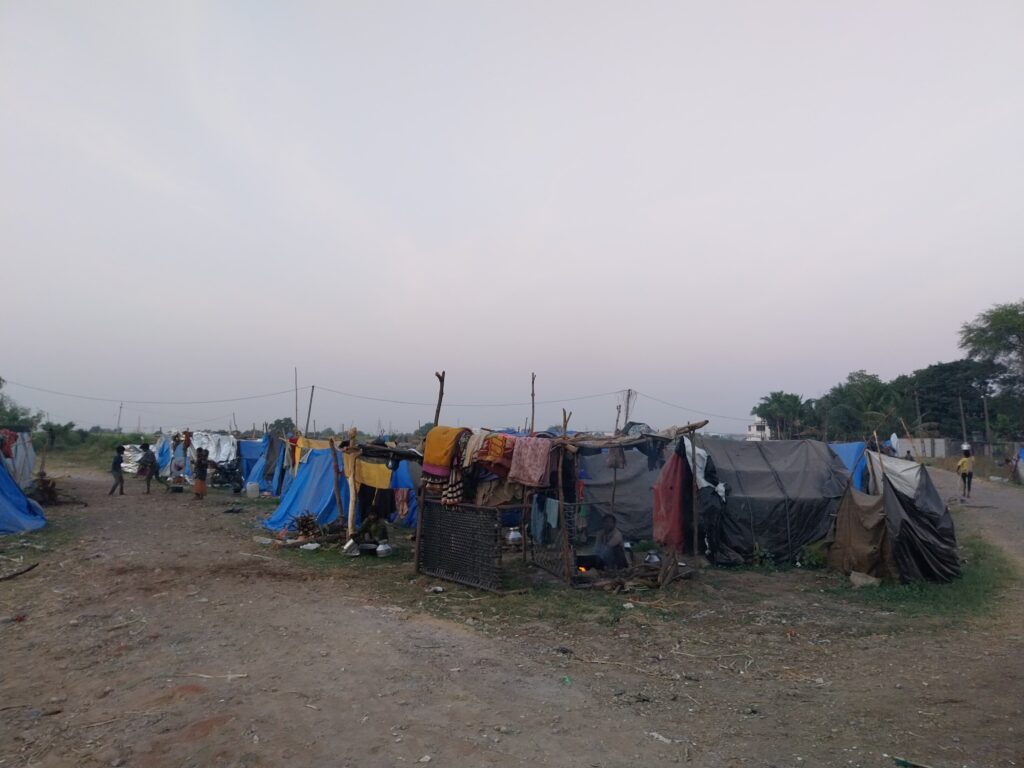Surat, the diamond and textile capital of India, attracts a large influx of migrant workers from various Indian states, including Odisha, Bihar, West Bengal, Jharkhand, Uttar Pradesh, Madhya Pradesh, Maharashtra, as well as neighboring Nepal. There is no data or estimate of their total number. Only in the power loom sector, the estimates vary from 7 lakhs to 12 lakhs. The city has insufficient infrastructure to cater to the housing demands of an influx this big. Living and working in Surat for the past 9 months, my work has taken me to the shelters of migrant laborers who power the city’s economy.
These pictures slipped from my phone’s gallery:
Sugarcane Farm Workers


Sugarcane farmers from Nandurbar, Maharashtra, journey to Surat the day after Dussehra and stay in the city until April, returning only after Gudi Padwa. They reside in temporary tents, relocating to a new village every two months based on harvest volume and targets. The workers typically migrate with their families, cooking and living in these tents. Basic sanitation is a challenge, with open defecation being a common practice.

The same water is used for washing, bathing, cooking, and all other purposes.
Sanitation Workers, Gig Economy, Drivers


These are 1BHK structures.
Construction Workers


During the monsoon, they return to their villages to work on the farms.

A shelter home for the homeless has been established in Katargam by the Surat Municipal Corporation, following advocacy and intervention by the Mahila Shram Shakti Kendra. The shelter primarily accommodates migrant laborers working in the construction sector.
Power Loom Workers
Mess rooms: These spaces provide both food and accommodation, with 4-5 people sharing each room.


A mess on Ved Road, Surat. In my 22 years of life, I’ve never encountered an accommodation site filthy as this. It’s nearly impossible to stay here for more than five minutes. This place houses power loom workers, and the unpleasant odor from the washrooms permeates even the kitchen. Food and accommodation here costs 3000 rupees per month.
Shared room facility: 8×10 rooms shared by 3-5 individuals, where, in most cases, they cook their own meals.


A housing facility at a worksite in Nandini. This is one of the cleanest worksite accommodations I have ever seen.
A 50-room building in Anjani for textile workers, providing shelter for 200-250 single male migrant laborers, with 4-5 workers sharing each room.

Sheltersquare Foundation
The images depict a grim reality—those who drive India’s growth are still denied basic recognition, with no official proof of their employment or residence. There is hope, thanks to the efforts of Sheltersquare Foundation. They have launched the Republic Hostel and Mess in Sayan, specifically designed for power loom workers. This 180-bed labor hostel is the first of its kind in India, offering much-needed safe and secure shelter to this community. The hostel provides both affordable accommodation and meals, ensuring essential support at reasonable costs.
Below are the pictures of India’s first labour hostel:







0 Comments